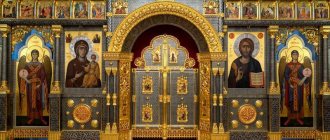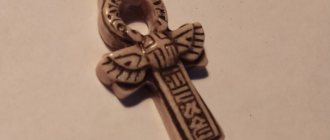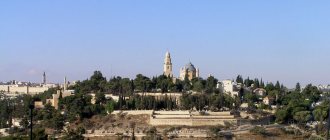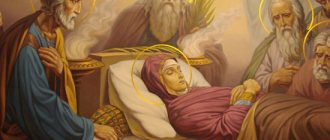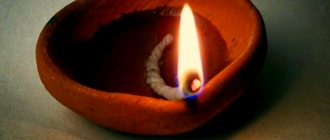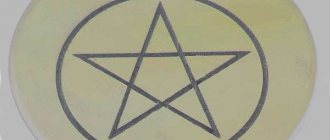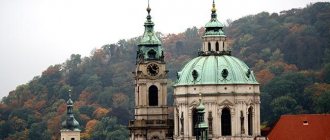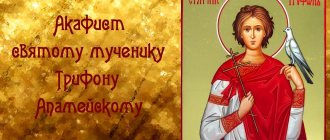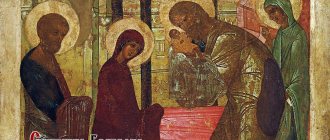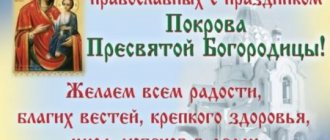If you look closely at Orthodox crosses, you will notice that at their base there is a crescent, which is not there by chance. The crescent on the cross or tsata is a symbol of Jesus Christ as King and also High Priest, but few people know about this. This symbol should remind parishioners of churches that their King and Lord is Jesus Christ, it is in search of him that everyone comes to church, which means it is worth throwing away extraneous thoughts and devoting time to the Lord. It is the crescent that symbolizes the Kingdom, as well as the high priesthood, which is why it is on Orthodox crosses.
History of the Crescent
The crescent, which was also commonly called tsata, was initially considered the state symbol of Byzantium; it symbolized power.
After the Turks conquered Constantinople and renamed it Istanbul, it became a symbol of the Ottoman Empire. In Ancient Rus', the crescent was also considered a symbol of power; it was customary to place it on images of princes.
Tsata was often placed on icons as an additional decoration. The crescent moon is found on the icons of the Trinity and the Mother of God, St. Nicholas the Wonderworker.
Tsata became widespread in Rus' in the 17th century; it was customary to depict it in the form of an inverted kokoshnik. Crosses with crescents were often installed on churches, which were constantly visited by rulers and princes. The symbol crowns many Kremlin cathedrals, as well as recently built churches in the Old Russian style.
Differences between crosses in the Orthodox faith
Fyodor the Studite argued that “a cross of any form is a true cross.” Therefore, for believers in Jesus Christ, regardless of religion, any cross is a sacred symbol. Among Catholics, you can most often see a four-pointed cross, and among Orthodox Christians, an eight-pointed one.
The above-mentioned tsata may be placed at the base of the Orthodox cross, but it is not an integral part of it. On the domes you can also see other images, such as stars, which symbolize the Star of Bethlehem and indicate the true path for every Orthodox Christian. A crown is also common. It indicates that the temple was built with money and by order of the ruling emperor, and also that the Head of the Church - Christ - is the One True King.
On some temples you can see a cross with beads. These beads represent the drops of Christ's blood that he shed for the salvation of mankind. People often call them “tears.” They also symbolize the repentant tears of believers. It is also customary to decorate crosses with grapevines, three-headed lilies (Holy Trinity), angels, doves, blossoming shoots (tree of life and symbol of paradise).
Moreover, the cross itself can be four-pointed, six-pointed or eight-pointed. All these are Christian canonical images.
Crescent on the cross - other interpretations
The Orthodox cross rising on the crescent symbolizes the victory of sunlight over the moon. There are other versions, according to which the meaning of the crescent moon changes.
It is also important to know that the cross became a symbol of Christianity only three centuries after the adoption of Christianity. Before this, it was not customary to place a cross on the graves of the deceased; instead, an anchor or an olive branch was used.
According to another version, the crescent moon is none other than the Bethlehem manger in which the infant Christ was found. In this interpretation, the cross rests on the cradle of Jesus. Another interpretation is that the ship of Christianity is led by the Savior; the cross acts as a sail.
The crescent also symbolized the anchor and was considered a symbol of unshakable faith in God. Confirmation of this concept can be found in the Bible, in the book of Hebrews.
The Christian religion provides security and allows one to strengthen oneself in a troubled sea. It is worth noting that all versions have the right to exist, as do the meanings that were put into religious symbols by generations of Christians.
False interpretations
Today there are still those who claim that the cross with a crescent symbolizes the victory of the Christian faith over Islam. But only illiterate people can reason this way, who do not know that such symbolism appeared long before the emergence of the Muslim religion.
Some associate it with paganism. The sun god was often depicted as a cross and symbolized light and day, and the crescent moon symbolized night and darkness. But such a statement is erroneous, since no drawings have been found anywhere that combine these two symbols. And the pagan cross has equal sides and thickenings, both at the base and at the ends.
False interpretations
When looking for answers to the question about the meaning of the crescent moon, one comes across an opinion about its connection with the Muslim religion. Christianity broadcasts its superiority over Islam to the world and tramples its symbol with its own. This opinion is not true. The crescent became a symbol of Islam only in the 15th century, and the combination of this symbol with a cross is found on monuments of the 6th century.
In this case, it is imperative to take into account that the oppression of another religion conflicts with the basic tenets of the Christian religion.
Other interpretations of the symbol
Photo: Flickr.com
Also, this symbol is considered a symbol of the Church-Wife, which is spoken of in the Revelation of John. Also, some interpret the crescent moon as a symbol of the dragon defeated by the Lord and falling exhausted at His feet. This once again reminds an Orthodox person that the Lord always defeats evil, which means that one must strive to lead a pious Christian life, not paying attention to all the temptations of this world.
Yes, this path is not easy, but the reward at the end is great - the opportunity to happily be with the Lord in eternity. The crescent on the cross is a symbol that successfully recalls the omnipotence of God, His justice, mercy, love for man and the sacrifice that was made in order to defeat sin and restore man's right to eternal life.
( 93 ratings, average: 3.71 out of 5)
Star and Crescent
These symbols were borrowed by Muslims from Ancient Byzantium, which they do not deny. These signs have an ancient history dating back thousands of years. According to some sources, these symbols were widely used in pagan cults that existed in different regions of Russia.
In early Islam, a variety of symbols were also used, later they were replaced by a single one. Today there are a large number of temples and shrines decorated with a star and crescent. In the minds of Muslims they are closely connected with Islam.
Crescent or boat: versions of the origin of the sign
There are several versions of what exactly the crescent moon on the Orthodox cross symbolizes. Among them we highlight the following:
- This sign is not a crescent at all. There is another ancient symbol that is visually similar to it. The cross as a symbol of Christianity was not immediately approved. Constantine the Great established Christianity as the main religion of Byzantium, and this required a new recognizable symbol. And for the first three centuries, the graves of Christians were decorated with other signs - a fish (in Greek “ichthys” - the monogram “Jesus Christ the Son of God the Savior”), an olive branch or an anchor.
- The anchor also has a special meaning in the Christian religion. This sign means hope and inviolability of faith.
- Also, the Bethlehem manger resembles a crescent moon. It was in them that Christ was found as a child. The cross rests on the birth of Christ and grows from his cradle.
- The Eucharistic cup, which contains the Body of Christ, may be implied by this sign.
- This is also a symbol of the ship led by Christ the Savior. The cross in this sense is a sail. The Church under this sail is sailing towards salvation in the Kingdom of God.
All these versions are true to some extent. Each generation has put its own meaning into this sign, which is so important for Christian believers.
Orthodox cross: meaning, shape, symbolism
Six-pointed Orthodox cross.
In Orthodoxy, a six-pointed crucifix is considered canonical: a vertical line is crossed by three transverse ones, one of them (the lower one) is oblique.
The upper horizontal crossbar (the shortest of the three transverse ones) symbolizes a tablet with an inscription in three languages (Greek, Latin and Hebrew): “Jesus of Nazareth, King of the Jews.”
This tablet, by order of Pontius Pilate, was nailed to the Cross of the Lord before the crucifixion.
The middle crossbar, shifted closer to the top (longest), is a direct part of the Cross - the hands of the Savior were nailed to it.
The lower oblique crossbar is a support for the legs. Unlike Catholics, in Orthodoxy on the Crucifixion both legs of the Savior are shown pierced by nails. This tradition is confirmed by studies of the Shroud of Turin - the cloth in which the body of the crucified Lord Jesus Christ was wrapped.
It is worth adding that the oblique shape of the lower crossbar carries a certain symbolic meaning.
The raised end of this crossbar rushes upward to the sky, thereby symbolizing the thief crucified at the right hand of the Savior, who, already on the cross, repented and entered with the Lord into the Kingdom of Heaven.
The other end of the crossbar, facing down, symbolizes the second thief, crucified on the left hand of the Savior, who blasphemed the Lord and did not receive forgiveness. The state of this robber’s soul is a state of God-forsakenness, of hell.
Athos cross.
There is another version of the Orthodox Crucifixion, the so-called full or Athos cross. It carries even more symbolic meanings. Its peculiarity is that certain letters are inscribed above the canonical six-pointed Cross.
What do the inscriptions on the cross mean?
Above the topmost crossbar is inscribed: “IS” - Jesus and “XC” - Christ. A little lower, along the edges of the middle crossbar: “SN” - Son and “BZHIY” - God. There are two inscriptions under the middle crossbar.
Along the edges: “TSR” - King and “SLOY” - Glory, and in (translated from Greek - victory).
This word means that with His suffering and death on the Cross, the Lord Jesus Christ conquered death and atoned for human sins.
On the sides of the Crucifixion are depicted a spear and a cane with a sponge, designated, respectively, by the letters “K” and “T”.
As we know from the Gospel, they pierced the Lord’s right rib with a spear, and they offered Him a sponge with vinegar on a cane in order to relieve His pain. The Lord refused to alleviate His suffering.
Below, the Crucifixion is depicted standing on the base - a small elevation, which symbolizes Mount Golgotha, on which the Lord was crucified.
Inside the mountain is the skull and crossbones of the forefather Adam. In accordance with this, on the sides of the elevation there is an inscription - “ML” and “RB” - Place of Execution and Crucified Byst, as well as two letters “G” - Golgotha. Inside Golgotha, on the sides of the skull, the letters “G” and “A” are placed - the head of Adam.
The image of Adam's remains has a certain symbolic meaning. The Lord, being crucified, sheds His blood on the remains of Adam, thereby washing and cleansing him from the fall he committed in paradise.
Together with Adam, the sins of all humanity are washed away. In the center of the crucifix there is also a circle with thorns - this is a symbol of the crown of thorns, which was put on the head of the Lord Jesus Christ by Roman soldiers.
Orthodox cross with crescent.
It is also worth mentioning another form of the Orthodox cross. In this case, the cross has a crescent at its base. Such crosses very often crown the domes of Orthodox churches.
According to one version, the cross emerging from the crescent symbolizes the birth of the Lord Jesus Christ. In the Eastern tradition, the crescent is often considered a symbol of the Mother of God - just as the cross is considered a symbol of Jesus Christ.
Another interpretation explains the crescent as a symbol of the Eucharistic cup with the blood of the Lord, from which, in fact, the Cross of the Lord is born. There is another interpretation regarding the cross emerging from the crescent.
This interpretation suggests understanding this as a victory (or rise, advantage) of Christianity over Islam. However, as research has shown, this interpretation is incorrect, since the very form of such a cross appeared much earlier than the 6th century, when, in fact, Islam arose.
Source: https://poleznosti.mirtesen.ru/blog/43133290004
Difference between Orthodox and Catholic crucifixes
In addition to the difference in the shape of the cross between Eastern and Western Christians, there are also differences in the crucifix itself. Knowing the important distinctive features of Orthodox and Catholic crucifixes, you can easily determine which direction of Christianity this symbol belongs to.
Differences between Orthodox and Catholic crucifixes:
- Number of nails visible in a crucifix
- Position of Christ's body
If in the Orthodox tradition four nails are depicted on the crucifix - for each hand and leg separately, then in the Catholic tradition the legs of Christ are crossed and nailed with one nail, respectively, there are three nails on the crucifix.
Orthodoxy explains the presence of four nails by the fact that the cross on which Christ was crucified, brought by Queen Helena from Jerusalem to Constantinople, had traces of four nails.
Catholics justify their version of the three nails by the fact that all the nails of the cross on which Christ was crucified are kept in the Vatican, and there are only three of them. In addition, the image on the Shroud of Turin is printed in such a way that the legs of the crucified man are crossed, therefore it can be assumed that Christ’s legs were nailed with one nail.
The position of the body of Christ on the Orthodox crucifix is a little unnatural; the body of Jesus does not hang on his hands, as it should have happened according to physical laws. On the Orthodox crucifix, Christ’s hands extend along the cross to the sides, as if calling “all the ends of the earth” (Is. 45:22). The crucifix does not attempt to reflect pain, it is more symbolic. Orthodoxy explains such features of the crucifixion by the fact that the cross is, first of all, a weapon of victory over death. The crucifix in Orthodoxy is a symbol of the victory of life over death, and, paradoxically, almost an object of joy, because it contains the idea of the Resurrection.
On a Catholic crucifix, the position of the body is as close as possible to physiological: the body sags in the arms by its own weight. The Catholic crucifixion is more realistic: often depicted bleeding blood, stigmata from nails, spears.
why on some crosses of Orthodox churches there is a crescent moon, see photo
why on some crosses of Orthodox churches there is a crescent moon, see photo
- First of all, you need to keep in mind that the crescent on the Orthodox cross has nothing to do with either the Muslim religion or victory over Muslims. Crosses with the image of a tsata (crescent) decorated ancient churches: the Church of the Intercession on the Nerl (1165), Demetrius Cathedral in Vladimir (1197) and others.
There could be no talk of any victory over the Muslims then.The crescent has been the state sign of Byzantium since ancient times, and only after 1453, when Constantinople was captured by the Turks, did this Christian symbol become the official emblem of the Ottoman Empire. In Orthodox Byzantium, tsata symbolized royal power.
Apparently, this is why it is placed as a symbol of grand-ducal dignity in the image of the Kyiv prince Yaroslav Izyaslavich in the Royal Chronicler of the 16th century. Often the tsata (crescent) is depicted as part of the holy vestment of St. Nicholas the Wonderworker.
It can also be found on other icons: the Holy Trinity, the Savior, the Blessed Virgin Mary. All this gives the right to consider that the figure on the cross is a symbol of the Lord Jesus Christ as King and High Priest.
Thus, the installation of a cross with a tsata on the dome of the temple reminds us that this temple belongs to the King of kings and the Lord of lords.
In addition, from ancient times, from Christ and the first centuries of Christianity, another meaning of the cross with a crescent came to us. In one of his epistles, the Apostle Paul teaches that Christians have the opportunity to take hold of the hope that is set before them, that is, the Cross, which is like a safe and strong anchor for the soul (Heb. 6:18-19).
This anchor, which at the same time symbolically covers the cross from the desecration of the pagans, and reveals to faithful Christians its true meaning of deliverance from the consequences of sin, is our strong hope. Only a church ship has the power to deliver everyone through the waves of a stormy temporary life to the quiet haven of eternal life.
On the domes of the Church of St. Sophia of Vologda (1570), the Holy Trinity Cathedral of Verkhoturye (1703), the Church of Blessed Cosmas in the city of Kostylevo, there are crosses with a bizarre ornament: twelve stars on rays emanating from the center and with a crescent below.
The symbolism of such a cross clearly conveys the image from the revelation of John the Theologian: And a great sign appeared in heaven: a woman clothed with the sun, with the moon under her feet, and on her head a crown of 12 stars, as a sign that, originally gathered from the 12 tribes of Israel, she subsequently led by 12 apostles, who constituted its luminous glory.
Sometimes the cross on a temple (with or without a crescent) is not eight-pointed, but four-pointed.
Many crosses on the ancient and most famous Orthodox cathedrals have exactly this shape, for example, the Hagia Sophia Cathedral in Constantinople (8th century), the Hagia Sophia Cathedral in Kiev (1152), the Assumption Cathedral in Vladimir (1158), the Church of the Savior in Pereyaslavl (1152 ) and many other temples. Starting from the 3rd century, when four-pointed crosses first appeared in the Roman catacombs, and until today, the entire Orthodox East considers this form of cross to be equal to others.
In addition to the above meanings of the crescent, in the patristic tradition there are others, for example, that it is the Bethlehem cradle that received the Infant Christ, the Eucharistic cup in which the Body of Christ is located, the church ship and the baptismal font.
That's how many meanings and mysterious spiritual meaning there are in the cross that shines above the dome of the temple.
- I think the cross and crescent are somehow connected
- The Altar Cross can be of different shapes, but it must certainly bear the image of the Crucifixion of Christ. Here it should be said about the dogmatic meanings of the forms of the Cross and various images of the Crucifixion. There are several basic forms of the Cross accepted by the Church.
The four-pointed, equilateral cross is a sign of the Cross of the Lord, dogmatically meaning that all ends of the universe, the four cardinal directions, are equally called to the Cross of Christ.A four-pointed cross with an elongated lower part highlights the idea of the long-suffering of Divine love, which gave the Son of God as a sacrifice on the cross for the sins of the world.
A four-pointed cross with a semicircle in the form of a crescent at the bottom, where the ends of the crescent are facing upward, is a very ancient type of Cross. Most often, such crosses were and are placed on the domes of churches. The cross and semicircle mean the anchor of salvation, the anchor of our hope, the anchor of rest in the Heavenly Kingdom, which is very consistent with the concept of the temple as a ship sailing to the Kingdom of God.
The eight-pointed cross has one middle crossbar longer than the others, above it one shorter straight crossbar, and under it there is also a short crossbar, one end of which is raised and faces north, and the lowered end faces south. The shape of this Cross most closely matches the Cross on which Christ was crucified. Therefore, such a Cross is no longer only a sign, but also an image of the Cross of Christ.
The upper crossbar is a tablet with the inscription “Jesus of Nazareth, King of the Jews,” nailed by order of Pilate above the head of the Crucified Savior.
The lower crossbar is a footrest, designed to serve to increase the torment of the Crucified, since the deceptive feeling of some support under his feet prompts the executed person to involuntarily try to lighten his weight by leaning on it, which only prolongs the torment itself.
Dogmatically, the eight ends of the Cross mean eight main periods in the history of mankind, where the eighth is the life of the next century, the Kingdom of Heaven, why one of the ends of such a Cross points up into the sky.
This also means that the path to the Heavenly Kingdom was opened by Christ through His Redemptive Feat, according to His word: “I am the way and the truth and the life” (John 14:6).
The slanting crossbar to which the Savior’s feet were nailed thus means that in the earthly life of people with the coming of Christ, who walked the earth preaching, the balance of all people, without exception, being under the power of sin was disrupted.
A new process of spiritual rebirth of people in Christ and their removal from the region of darkness into the region of heavenly light has begun in the world. This movement of saving people, raising them from earth to heaven, corresponding to the feet of Christ as the organ of movement of a person making his way, is what the oblique crossbar of the eight-pointed Cross represents.
When the eight-pointed Cross depicts the crucified Lord Jesus Christ, the Cross as a whole becomes a complete image of the Savior’s Crucifixion and therefore contains all the fullness of the power contained in the Lord’s suffering on the cross, the mysterious presence of Christ crucified. This is a great and terrible shrine.
- The crescent is not a crescent, but a Jewish sacrificial cup for draining blood. Refer to the symbols of Judaism and you will understand everything. They managed to stick the stars of David-Magendavid into these crosses. Judaism is everything in Christianity.
- This is a symbol of victory over the Turks. It’s like a cross over a crescent, well, I think the meaning is clear.
- The official explanation of the Orthodox Church is this: the defeated crescent present on church crosses means the victory of Christianity over Islam.
- 1. The eight-pointed cross is a classic ancient Orthodox cross. 2. The crescent at the base of the cross symbolizes the Mother of God.
Cross with crescent on the dome of the Temple
The main parts of the Cross (in real and symbolic meaning) were two beams: one vertical (the largest), the other horizontal, connected to the first at a right angle.
The Savior of the world was nailed to them. The Romans called it crux immissa (hammered cross). At the top of the Calvary Cross there was a small tablet - titulus (title). She is spoken of in St. Gospel: “Pilate wrote an inscription and placed it on the cross. It was written: Jesus of Nazareth, King of the Jews.
This inscription was read by many of the Jews, because the place where Jesus was crucified was not far from the city, and it was written in Hebrew, Greek, and Roman” (John 19:19-20). The third crossbar was the foot. Without it, the body attached to the tree, hanging for many hours on only nails, could fall off.
The crescent at the base of the Cross gives it a resemblance to an anchor, which among ancient Christians was a symbol of hope, and the Church was a ship of salvation in the stormy sea of life. We find this thought in St. Apostle Paul (see Heb. 6:18-19).
Some researchers see here a symbolic expression of an apocalyptic image relating to the Mother of God: “And a great sign appeared in the sky: a woman clothed with the sun; under her feet is the moon, and on her head is a crown of twelve stars” (Rev. 12:1). The Church calls Jesus Christ the Sun of Truth.
There is also an interpretation: the crescent is the Cup into which the Blood of the Savior flowed - a symbol of the sacrament of the Eucharist. At the upper end of the Cross, a dove is sometimes depicted - a symbol of the Holy Spirit. During the Baptism of the Lord, “John saw the Spirit of God descending like a dove and descending on Him. And behold, a voice from heaven said: This is my beloved Son, in whom I am well pleased” (Matthew 3:16-17).
And more about the cross with a crescent from the site https://www.pravmir.ru
In their external shape, domed crosses often differ from the eight-pointed ones we are used to. The cross on the dome expresses the idea of the temple as the House of God and the ship of Salvation and has corresponding symbolism. Questions and confusion arise especially often about the crescent (tsata), located at the bottom of the cross.
What is the meaning of this symbol? First of all, you need to keep in mind that the crescent on the Orthodox cross has nothing to do with either the Muslim religion or victory over Muslims. Crosses with the image of a tsata (crescent) decorated ancient churches: the Church of the Intercession on the Nerl (1165), Demetrius Cathedral in Vladimir (1197) and others.
There was no talk of any victory over the Muslims then. The crescent had been the state sign of Byzantium since ancient times, and only after 1453, when Constantinople was taken by the Turks, did this Christian symbol become the official emblem of the Ottoman Empire. In Orthodox Byzantium, tsata symbolized royal power.
Apparently, this is why it is placed as a symbol of grand-ducal dignity in the image of the Kyiv prince Yaroslav Izyaslavich in the “Royal Chronicler” of the 16th century. Often the tsata (crescent) is depicted as part of the holy vestment of St. Nicholas the Wonderworker. It can also be found on other icons: the Holy Trinity, the Savior, the Blessed Virgin Mary.
All this gives the right to believe that the figure on the cross is a symbol of the Lord Jesus Christ as King and High Priest. Thus, the installation of a cross with a tsata on the dome of the temple reminds us that this temple belongs to the King of kings and the Lord of lords.
In addition, from ancient times - from Christ and the first centuries of Christianity - another meaning of the cross with a crescent came to us. In one of his epistles, the Apostle Paul teaches that Christians have the opportunity to “take hold of the hope that is set before us, that is, the Cross, which is like a safe and strong anchor for the soul” (Heb. 6:18-19).
This “anchor”, which at the same time symbolically covers the cross from the desecration of the pagans, and reveals to faithful Christians its true meaning - deliverance from the consequences of sin, is our strong hope. Only a church ship has the power to deliver everyone through the waves of a stormy temporary life to the quiet haven of eternal life.
On the domes of the Church of St. Sophia of Vologda (1570), the Holy Trinity Cathedral of Verkhoturye (1703), the Church of Blessed Cosmas in the city of Kostylevo, there are crosses with a bizarre ornament: twelve stars on rays emanating from the center and with a crescent below.
The symbolism of such a cross clearly conveys the image from the revelation of John the Theologian: “And a great sign appeared in heaven: a woman clothed with the sun, with the moon under her feet, and on her head a crown of 12 stars” - as a sign that, originally assembled from 12 tribes Israel, it was subsequently led by 12 apostles, who constituted its luminous glory.
Sometimes the cross on a temple (with or without a crescent) is not eight-pointed, but four-pointed.
Many crosses on the ancient and most famous Orthodox cathedrals have exactly this form - for example, the Hagia Sophia Cathedral in Constantinople (8th century), the Hagia Sophia Cathedral in Kiev (1152), the Assumption Cathedral in Vladimir (1158), the Church of the Savior in Pereyaslavl (1152 year) and many other temples. Starting from the 3rd century, when four-pointed crosses first appeared in the Roman catacombs, and until today, the entire Orthodox East considers this form of cross to be equal to others. In addition to the above meanings of the crescent, there are others in the patristic tradition - for example, that this is the cradle of Bethlehem, which received the Divine Infant Christ , the Eucharistic cup in which the Body of Christ is located, the church ship and the baptismal font.
That's how many meanings and mysterious spiritual meaning there are in the cross that shines above the dome of the temple.
Material sent by Irina Kuznetsova
Add comments can only registered users. [Registration | Entrance ]
Source: https://happy-school.ru/publ/voskresnaja_shkola/voprosy_i_otvety/krest_s_polumesjacem_na_kupole_khrama/115-1-0-5985
Votive cross
In Rus' there was a custom to erect votive crosses in honor of memorable dates or holidays. Usually such events were associated with the death of a large number of people. It could be fires or famine, or a cold winter. Crosses could also be installed as gratitude for deliverance from any misfortune.
In the city of Mezen in the 18th century, 9 such crosses were installed, when during a very harsh winter, all the inhabitants of the city almost died. In the Novgorod principality, personalized votive crosses were installed. After that, the tradition passed to the northern Russian principalities.
Sometimes certain people would erect a votive cross to mark a specific event. Such crosses often bore the names of the people who created them. For example, in the Arkhangelsk region there is the village of Koinas, where there is a cross called Tatyanin. According to the residents of this village, the cross was installed by a fellow villager who made such a vow. When his wife Tatyana was overcome by illness, he decided to take her to a church that was located far away, since there were no other churches nearby, after which his wife recovered. It was then that this cross appeared.
Moon on the icons of the Mother of God. Why is there a month on the Orthodox cross?
Yesterday's discovery of the Moon on the icon of the Mother of God in the Church of the Sign of Our Lady in Dubrovitsy gave rise to a number of questions in me, and I began to dig for information. The moon is indeed a rather rare phenomenon on icons.
Although John the Theologian has the following words: “A woman clothed with the sun, with the moon under Her feet and on Her head a crown of twelve stars” (Ap 12:1). I found only three icons of the Mother of God that have the attributes described by John the Theologian: 1. Mammal Greece, 1750, 16x12.4 cm.
2. Ostrobramskaya Icon of the Mother of God (in the Temples of Kyiv and Krakow)
3. And the actual icon of the Mother of God in the Church of the Sign of Our Lady in Dubrovitsy. I have already made an analogy with the III Arcana of the Tarot - the Empress. It is likely that the Moon on the Empress’s card symbolizes the feminine principle, on which she (the Empress) rests with her left (female) leg. Here is a classic image of the III Arcana of the Tarot - the Empress trampling on the Moon with her left foot (from the previous post).
Continuing the theme of the Moon, I had another logical question : What does the Moon (crescent) on an Orthodox cross mean?
I found several versions on the web:
1) Muslim.
The Moon under the Cross, as a symbol of the victory of Orthodoxy over Islam during the period of the Tatar-Mongol invasions.
This option does not stand up to criticism. Firstly, the Tatar-Mongols did not represent a single people, they did not have a single religion. Genghis Khan, for example, believed in a Supreme Heavenly Being, and Islam spread only under Uzbek Khan.
Important
In addition, the Tatar-Mongols were distinguished by significant religious tolerance, therefore religious issues were not the main ones. In addition, the cross with a crescent arose long before the Mongol-Tatar invasion. Such a cross stands on the dome of the Dmitrievsky Cathedral in Vladimir (XII century), for example.
2) Pagan.
The Moon with the Cross as traditional solar-lunar symbolism, where the Cross is a symbol of the Sun (remember the swastika), a symbol of the Masculine principle, and the crescent is, accordingly, a symbol of the Moon, a symbol of the Feminine principle. Their combination.
Just what are they doing on the dome of Orthodox churches? The third version answers this question.
3) Christian.
Very many symbols and rituals of the Christian church are not newly introduced (invented by the church), but only “churched” symbols of previous “beliefs”, endowed with new meanings and meanings. This is the situation we have in the context of the Cross with a Crescent, where the Cross becomes a symbol of Christ, and the month becomes a symbol of the Mother of God.
It is interesting in this regard, why the domes of the church are crowned with the symbol of Christ and the Mother of God, and not, for example, with the symbol of the Trinity (God the Father, God the Son and the Holy Spirit)? Wouldn't it be more logical? Maybe there are other versions?
The most complete and interesting article on this topic was the article by B.A. Uspensky “Solar-lunar symbolism in the appearance of a Russian temple.”
Source: https://vse-horosho.livejournal.com/25236.html
